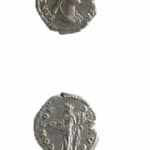Silver Denarius of Empress Sabina, 120 CE - 136 CE
Silver
C.5419
Further images
Obv: Draped bust of Sabina facing right Rev: Corcordia facing left Vibia Sabina’s parents died when she was very young and she was raised by her uncle, the Emperor Trajan,...
Obv: Draped bust of Sabina facing right
Rev: Corcordia facing left
Vibia Sabina’s parents died when she was very young and she was raised by her uncle, the Emperor Trajan, whose fondness for his nephew Hadrian brought about his marriage to Sabina in 100 AD when she was 16. Like the other two women of the Nervo-Trajanic dynasty, she had no children of her own and instead raised two adoptees named Lucius Aelius and Antoninus Pius. She is said to have aborted at least one child, stating that any child of Hadrian’s would “harm the human race”; this was, unfortunately, to be the general tone of their marriage.
She was said to have been exceptionally strong minded and somewhat difficult for Hadrian to control. She also had an affair with one of Hadrian’s slave boys in the 120’s. This said, she was dutiful towards her husband and nation. Her devotion was awarded with the title of Augusta in 128 AD. The marriage endured to her death – arguably by poisoning at Hadrian’s hand, although this is unlikely – in 136/7.
Representations of Sabina follow the general remit of honorific coins produced to commemorate the spouses of famous emperors. Statues show her as being a fairly plain, solidly matriarchal woman, but with a finely moderated face that could be said to reflect the unfortunate circumstances of her time when women were essentially traded like goods. At this time, Roman coiffures were at their most flamboyant, and Sabina seems to have been devoted to her appearance judging from the complexity of her hair in the current case. The triple-tiered look which sometimes appears is known as stephane – tiaras – descended from the Greek word for crown (stephanos).
Concordia is the Roman goddess of understanding, concordance/agreement and – perhaps ironically – marital accord. Cults to Concordia were a common character of the early-mid Roman Empire, as imperial harmony was a much-desired by the ruling elite of the time. She is shown holding either a cornucopia (horn of plenty), a caduceus (emblem of peace) or a patera (sacrificial bowl). She is often associated with a status of Spes, the goddess of hope (or “last chance” goddess), which she uses as an armrest. All these items refer to the stability, prosperity and balance that the Roman emperors liked to believe their reigns brought to the Empire.
Rev: Corcordia facing left
Vibia Sabina’s parents died when she was very young and she was raised by her uncle, the Emperor Trajan, whose fondness for his nephew Hadrian brought about his marriage to Sabina in 100 AD when she was 16. Like the other two women of the Nervo-Trajanic dynasty, she had no children of her own and instead raised two adoptees named Lucius Aelius and Antoninus Pius. She is said to have aborted at least one child, stating that any child of Hadrian’s would “harm the human race”; this was, unfortunately, to be the general tone of their marriage.
She was said to have been exceptionally strong minded and somewhat difficult for Hadrian to control. She also had an affair with one of Hadrian’s slave boys in the 120’s. This said, she was dutiful towards her husband and nation. Her devotion was awarded with the title of Augusta in 128 AD. The marriage endured to her death – arguably by poisoning at Hadrian’s hand, although this is unlikely – in 136/7.
Representations of Sabina follow the general remit of honorific coins produced to commemorate the spouses of famous emperors. Statues show her as being a fairly plain, solidly matriarchal woman, but with a finely moderated face that could be said to reflect the unfortunate circumstances of her time when women were essentially traded like goods. At this time, Roman coiffures were at their most flamboyant, and Sabina seems to have been devoted to her appearance judging from the complexity of her hair in the current case. The triple-tiered look which sometimes appears is known as stephane – tiaras – descended from the Greek word for crown (stephanos).
Concordia is the Roman goddess of understanding, concordance/agreement and – perhaps ironically – marital accord. Cults to Concordia were a common character of the early-mid Roman Empire, as imperial harmony was a much-desired by the ruling elite of the time. She is shown holding either a cornucopia (horn of plenty), a caduceus (emblem of peace) or a patera (sacrificial bowl). She is often associated with a status of Spes, the goddess of hope (or “last chance” goddess), which she uses as an armrest. All these items refer to the stability, prosperity and balance that the Roman emperors liked to believe their reigns brought to the Empire.





